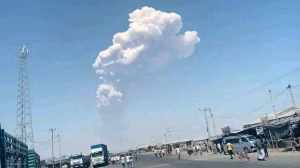From Russia to Japan: Top 10 most powerful earthquakes in history
Top 10 most powerful earthquakes in the world: An 8.8 magnitude earthquake hit off the coast of Russia's Kamchatka Peninsula, setting off tsunami warnings around the world.
 Top 10 most powerful earthquakes
Top 10 most powerful earthquakesTop 10 most powerful earthquakes in the world: A colossal 8.8 magnitude earthquake rocked the waters off Russia’s Kamchatka Peninsula early Wednesday, rattling buildings and prompting urgent tsunami warnings across the Pacific from Hawaii to Japan.
The US Geological Survey (USGS) reported that the quake struck at a depth of 74 km, with its epicentre roughly 133 km southeast of Petropavlovsk-Kamchatsky, over 6,800 km away from Moscow. Tsunami alerts were issued for Russia, Japan, Hawaii, and multiple Pacific islands as authorities raced to assess the threat.
While the full scale of the destruction is still coming into focus, early video clips reveal intense ground motion, toppled furniture, and chaotic evacuations in cities near the epicentre.
With an initial reading of magnitude 8.8, this seismic event is now among the most powerful ever documented. It stands shoulder to shoulder with historic earthquakes that have reshaped coastlines and claimed thousands of lives, as per USGS.
In light of this massive quake, here is a list of the world’s most powerful earthquakes:
| Rank | Country | Year | Earthquake Magnitude |
| 1. | Valdivia, Chile | 1960 | 9.5 |
| 2. | Prince William Sound, Alaska | 1964 | 9.2 |
| 3. | Sumatra, Indonesia | 2004 | 9.1 |
| 4. | Tohoku, Japan | 2011 | 9.1 |
| 5. | Kamchatka, Russia | 1952 | 9.0 |
| 6. | Kamchatka Peninsula, Russia | 2025 | 8.8 |
| 7. | Maule, Chile | 2010 | 8.8 |
| 8. | Esmeraldas, Ecuador | 1906 | 8.8 |
| 9. | Rat Islands, Alaska | 1965 | 8.7 |
| 10. | Tibet | 1950 | 8.6 |
Source: US Geological Survey
Valdivia, Chile – 1960 (Magnitude 9.5)
 Valdivia, Chile was hit with a 9.5 magnitude earthquake in 1960
Valdivia, Chile was hit with a 9.5 magnitude earthquake in 1960
The strongest earthquake ever documented hit central Chile, claiming the lives of over 1,600 people, most of them victims of the massive tsunami that followed. The disaster left thousands more injured and caused extensive damage not only throughout Chile but also in distant regions affected by the seismic waves.
Prince William Sound, Alaska – 1964 (Magnitude 9.2)
 Prince William Sound, Alaska was hit with a 9.2 magnitude earthquake in 1964
Prince William Sound, Alaska was hit with a 9.2 magnitude earthquake in 1964
The most powerful earthquake in US history shook the ground for almost five minutes, triggering deadly landslides and a catastrophic tsunami that led to over 130 fatalities. The region continued to experience aftershocks for several weeks following the initial quake.
Sumatra, Indonesia – 2004 (Magnitude 9.1)
This underwater quake, followed by a devastating tsunami, claimed the lives of over 230,000 people across Southeast Asia and parts of East Africa. Indonesia bore the brunt of the catastrophe, with more than 167,000 fatalities as entire towns and villages were obliterated.
Tohoku, Japan – 2011 (Magnitude 9.1)
 Tohoku, Japan was hit with a 9.1 magnitude earthquake in 2011
Tohoku, Japan was hit with a 9.1 magnitude earthquake in 2011
The underwater earthquake set off a devastating tsunami that led to the Fukushima nuclear crisis. The disaster claimed the lives of over 18,000 people, either killed or unaccounted for, while entire coastal towns were wiped out and long-term fears over radiation contamination lingered for years.
Kamchatka, Russia – 1952 (Magnitude 9.0)
Although no deaths have been reported, the powerful earthquake unleashed a tsunami that surged across the Pacific, with towering waves up to 30 feet high slamming into Hawaii, a stark reminder of how far-reaching and destructive seismic activity in the Pacific Rim can be.
Kamchatka Peninsula, Russia – 2025 (Magnitude 8.8)
An 8.8 magnitude earthquake hit off the coast of Russia’s Kamchatka Peninsula, setting off tsunami warnings around the world. It stands as the most powerful earthquake recorded globally since 2011 and the strongest to strike Russia in more than 70 years, surpassing any since 1952.
Maule, Chile – 2010 (Magnitude 8.8)
 Maule, Chile earthquake 2010
Maule, Chile earthquake 2010
In 2010, central Chile was rocked by a massive earthquake that lasted more than 90 seconds, unleashing widespread destruction. A powerful tsunami followed, sweeping away coastal towns and contributing to a death toll of over 500 people. The capital city, Santiago, was left reeling with heavy structural damage and disrupted infrastructure.
Esmeraldas, Ecuador – 1906 (Magnitude 8.8)
One of the deadliest quakes in Ecuador’s history struck off the coast near Esmeraldas in 1906. The shaking and resulting tsunami led to approximately 1,500 fatalities. The tremor’s strength was so great that it was felt far beyond Ecuador’s borders — all the way up to Central America, and even as distant as San Francisco and Japan.
Rat Islands, Alaska – 1965 (Magnitude 8.7)
 Rat Islands, Alaska, was hit with a 8.7 magnitude earthquake in 1965
Rat Islands, Alaska, was hit with a 8.7 magnitude earthquake in 1965
In 1965, a powerful earthquake hit the remote Rat Islands in Alaska’s Aleutian chain. Despite triggering a tsunami that reached heights of 35 feet, the impact on human settlements was minimal due to the area’s isolation. The event, however, reinforced the seismic risks along the volatile tectonic boundary.
Tibet – 1950 (Magnitude 8.6)
An enormous earthquake struck the Tibet-Assam border region in 1950, devastating villages and leading to the deaths of at least 780 people. Beyond the initial destruction, landslides buried entire communities, and days later, a natural dam burst in northeastern India, sending a 23-foot wall of water crashing downstream, worsening the disaster.




- 01
- 02
- 03
- 04
- 05



























